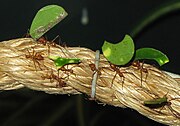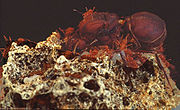Leaf-cutter ant





Leafcutter ant is the general name for any of 47 species of leaf-chewing ants of the two genera Atta and Acromyrmex.[1] These species of tropical, fungus-growing ants are all endemic to South and Central America, Mexico and parts of the southern United States.[2] Leafcutter ants "cut and process fresh vegetation (leaves, flowers, and grasses) to serve as nutrition for their fungal cultivars".[3]
The Acromyrmex and Atta ants have much in common anatomically; however, the two can be identified by their external differences. Atta ants have three pairs of spines and a smooth exoskeleton on the upper surface of the thorax, while Acromyrmex ants have four pairs and a rough exoskeleton.[4]
Next to humans, leafcutter ants form the largest and most complex animal societies on Earth. In a few years, the central mound of their underground nests can grow to more than 30 metres (98 ft) across, with smaller, radiating mounds extending out to a radius of 80 metres (260 ft), taking up 30 to 600 square metres (320 to 6,460 sq ft) and containing eight million individuals.[5]
Colony life cycle
[change | change source]Reproduction and colony founding
[change | change source]Winged females and males leave their respective nests en masse and engage in a nuptial flight known as the revoada. Each female mates with multiple males to collect the 300 million sperm she needs to set up a colony.[6]
Once on the ground, the female loses her wings and searches for a suitable underground lair in which to found her colony. The success rate of these young queens is very low, and only 2.5% will go on to establish a long-lived colony. To start her own fungus garden, the queen stores bits of the parental fungus garden mycelium in a pocket in her mouth.[7]
Colony hierarchy
[change | change source]In a mature leafcutter colony, ants are divided into castes, based mostly on size, that do different work. Acromyrmex and Atta show a high degree of biological polymorphism, with four castes in established colonies - minims, minors, mediae and majors. Majors are also known as soldiers. Atta ants are more polymorphic than Acromyrmex, meaning there is comparatively less difference in size from the smallest to largest types of Acromymex.
- Minims are the smallest workers, and look after the growing brood or care for the fungus gardens. Head width is less than 1 mm.
- Minors are slightly larger than minim workers, and are present in large numbers in and around foraging columns. These ants are the first line of defense. They continuously patrol the surrounding terrain and vigorously attack any enemies that threaten the foraging lines. Head width is around 1.8-2.2 mm.
- Mediae are the foragers which cut leaves and bring the leaf fragments back to the nest.
- Majors, the largest worker ants, act as soldiers, defending the nest from intruders. They also do other things, like clearing the main foraging trails of large debris and carrying bulky items back to the nest. The largest soldiers (Atta laevigata) may have body lengths up to 16 mm and head widths of 7 mm.
Life-style
[change | change source]"Leaf-cutter ants are the major forest herbivores in Central America and consume more plant matter than all the vertebrate herbivores put together. Their subterranean nests can be vast and home to many millions of ants and they have a really neat defence system where minor workers ride shotgun on top of the leaf loads carried by the major workers and fend off the attacks of parasitic flies". George McGavin.[5]
References
[change | change source]- ↑ Speight, Martin R.; Watt, Allan D.; Hunter, Mark D. (1999). Ecology of Insects. Blackwell Science. p. 156. ISBN 0-86542-745-3..
- ↑ Hölldobler B. & Wilson E.O. 1990. The ants. Harvard University Press. ISBN 978-3-540-52092-4
- ↑ Schultz, T. R.; Brady, S. G. (2008). "Major evolutionary transitions in ant agriculture". Proceedings of the National Academy of Sciences of the United States of America. 105 (14): 5435–5440. Bibcode:2008PNAS..105.5435S. doi:10.1073/pnas.0711024105. PMC 2291119. PMID 18362345.
- ↑ Hedlund, Kye S. (2005), Diagnoses of the North American ant enera (Hymenoptera: Formicidae), archived from the original on 2007-08-24, retrieved 2012-10-17.
- ↑ 5.0 5.1 McGavin, George n.d. Supernature, BBC Nature. [1] Archived 2015-09-25 at the Wayback Machine Includes a video clip from David Attenborough's BBC series Trials of nature, with detailed commentary.
- ↑ Piper, Ross (2007), Extraordinary animals: an encyclopedia of curious and unusual animals, Greenwood Press, p. 298, ISBN 978-0-313-33922-6.
- ↑ Weber, Neal A. (1972), Gardening ants, the Attines, The American Philosophical Society, pp. 14, 34, ISBN 0-87169-092-6.